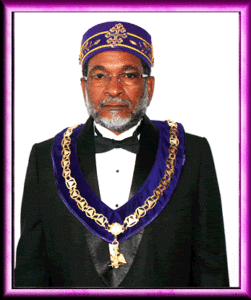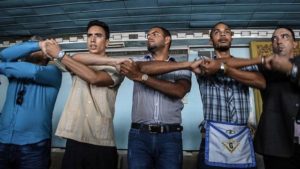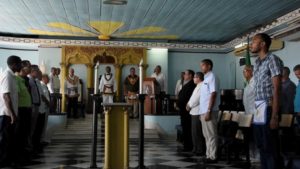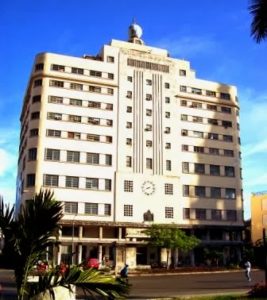THE RETURN OF CUBAN FREEMASONRY AFTER A LONG JOURNEY.
Immaculately dressed in white, with a collar and apron, he crosses the columns of Solomon, he climbs the seven symbolic steps: Lázaro Cuesta is the first black man to achieve the dignity of Grand Master of the Grand Lodge of Cuba in 150 years.
According to an AFP report, Cuesta feels escorted by the Cuban flag and the one of the beehive with seven bees, the one of the “institution”.
It is June 24, day of modern Freemasonry, 300th anniversary of the Lodge of England. Wine glasses are handed out.
Cuesta raises his right hand and makes the first of seven ritual toasts. “Prepare weapons, aim, fire,” orders the master of ceremonies for each sip.
At 72 years of age and 50 years of freemasonry, Cuesta is one of the survivors of a storm that stigmatized Masons after the arrival of Fidel Castro in 1959 and until 1990.
“We overcame a crisis in the beginning of the 60s and 70s … a great number of Freemason brothers decided to leave the country for one reason or another, and Freemasonry became depressed,” he told the French news agency.
In April 1961 Castro declared himself a Socialist, nationalized the teaching and promulgated an urban reform, cutting off the sources of financing for Masons and churches.
Cuba was the only socialist country “where the masonic workshops continued to function and work”, defends in its work the official historian Eduardo Torres-Cuevas, director of the National Library.
Being a believer, Mason, was not a crime, but a stigma that limited access to state jobs, the employer of 90% of Cubans.
“Many brothers had to leave Freemasonry, their legs were loosened, because if you were in Freemasonry you could not work,” says Velez at his house, surrounded by Shangó attributes.
Of 34,000 members, the Grand Lodge stood at 19,500.
After 1991 “a large number of young men were interested in entering Freemasonry … and there has been a remarkable growth”, reaching the current 27,800, integrated in 321 lodges, he says. But rebirth brought no resources.
On the ceiling of the room are represented day and night. The floor is black and white, in racial allusion.
There are statues of Venus (beauty), Athena (wisdom) and Hercules (strength). A stone without tillage symbolizes apprentices; An angular one, to those already formed.
The Great Architect, represented by an all-seeing eye, is the supreme maker, and each one renders worship according to his beliefs.
Cuesta, a low and solid carpenter, is also a priest of African cults (babalawo), whose great deity is Ifá. A few years ago began the reconstruction of the Masonic asylum Llansó.
He touched many doors like that of the Historian of Havana, where he found some help. Also in the United States and Europe. “A great job,” says Vélez.
With the Government “they are respectful relations … but we consider that there could be a much wider possibility”, says Cuesta, who is confident that Cuban masonry will continue its recovery.
EL REGRESO DE LA MASONERÍA CUBANA TRAS UN LARGO CAMINO RECORRIDO.

Lázaro Cuesta, gran maestro de la Gran Logia de Cuba, en el templo masón de La Habana, el 27 de junio de 2017. (AFP)
Vestido impecablemente de blanco, con collarín y mandil, cruza las columnas de Salomón, sube los siete escalones simbólicos: Lázaro Cuesta es el primer negro que alcanza la dignidad de Gran Maestro de la Gran Logia de Cuba en 150 años.
De acuerdo con un reportaje de la AFP, Cuesta se sienta escoltado por la bandera cubana y la de la colmena con siete abejas, la de la “institución”.
Es 24 de junio, día de la masonería moderna, aniversario 300 de la Logia de Inglaterra. Se reparten copas de vino.
Cuesta levanta su mano derecha y hace el primero de siete brindis rituales. “Preparen armas, apunten, fuego”, ordena el maestro de ceremonias para cada sorbo.

Después los masones entrelazan sus manos en una “cadena fraternal” y proclaman “Libertad, igualdad, fraternidad”.
A los 72 años de edad y 50 de masonería, Cuesta es uno de los sobrevivientes de una tormenta que estigmatizó a los masones tras la llegada al poder de Fidel Castro en 1959 y hasta 1990.
“Superamos una crisis en principio de las décadas de años 60 y 70 (…) una gran cantidad de hermanos masones decidieron dejar el país por una razón u otra, y la masonería quedó deprimida”, dice a la agencia francesa.
En abril de 1961 Castro se declaró socialista, nacionalizó la enseñanza y promulgó una reforma urbana, cortando las fuentes de financiamiento de los masones y las iglesias.
Cuba fue el único país socialista “donde continuaron funcionando y trabajando los talleres masónicos”, defiende en su obra el historiador oficialista Eduardo Torres-Cuevas, director de la Biblioteca Nacional.
Ser creyente, masón, no era un delito, pero sí un estigma que limitaba el acceso a puestos del Estado, el empleador del 90% de los cubanos.
“Muchos hermanos tuvieron que dejar la masonería, se les aflojaron las patas, porque si estabas en la masonería no podías trabajar”, dice Vélez en su casa, rodeado de atributos de Shangó.
De 34.000 miembros, la Gran Logia quedó en 19.500.
Después de 1991 “una gran cantidad de hombres jóvenes se interesaron en ingresar a la masonería (…) y ha habido un notable crecimiento”, hasta llegar a los 27.800 actuales, integrados en 321 logias, señala. Pero el renacer no trajo recursos.
En el techo del salón están representados el día y la noche. El piso es blanco y negro, en alusión racial.
Hay estatuas de Venus (belleza), Atenea (sabiduría) y Hércules (fuerza). Una piedra sin labrar simboliza a los aprendices; una angulosa, a los ya formados.
El Gran Arquitecto, representado por un ojo omnividente, es el supremo hacedor y cada quien le rinde culto según sus creencias.
Cuesta, carpintero bajo y macizo, es también sacerdote de cultos africanos (babalawo), cuya gran deidad es Ifá. Hace unos años inició la reconstrucción del asilo masónico Llansó.
Tocó muchas puertas como la del Historiador de La Habana, donde encontró alguna ayuda. También en Estados Unidos y Europa. “Un gran trabajo”, dice Vélez.
Con el Gobierno “son relaciones respetuosas (…) pero consideramos que pudiera existir una posibilidad mucho más amplia”, opina Cuesta, quien confía en que la masonería cubana seguirá su remontada.
Agencies/DDC/AFP/Internet Photos/Excerpts/Arnoldo Varona/TheCubanHistory.com
THE CUBAN HISTORY, HOLLYWOOD.



 THE RETURN of the Cuban Freemasonry after a long journey. + EL REGRESO de la Masonería Cubana tras un largo camino recorrido.
THE RETURN of the Cuban Freemasonry after a long journey. + EL REGRESO de la Masonería Cubana tras un largo camino recorrido.




